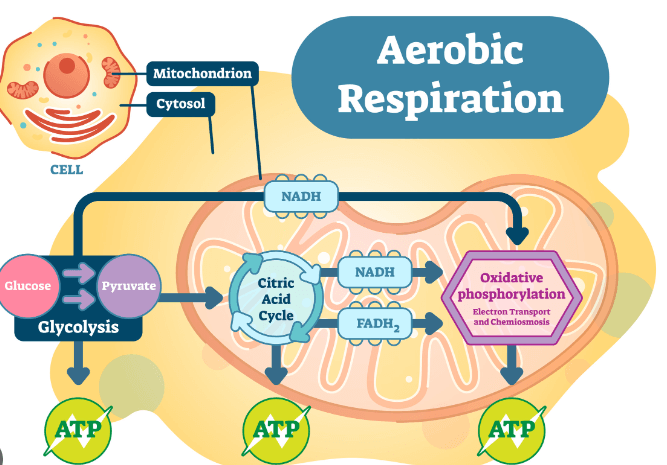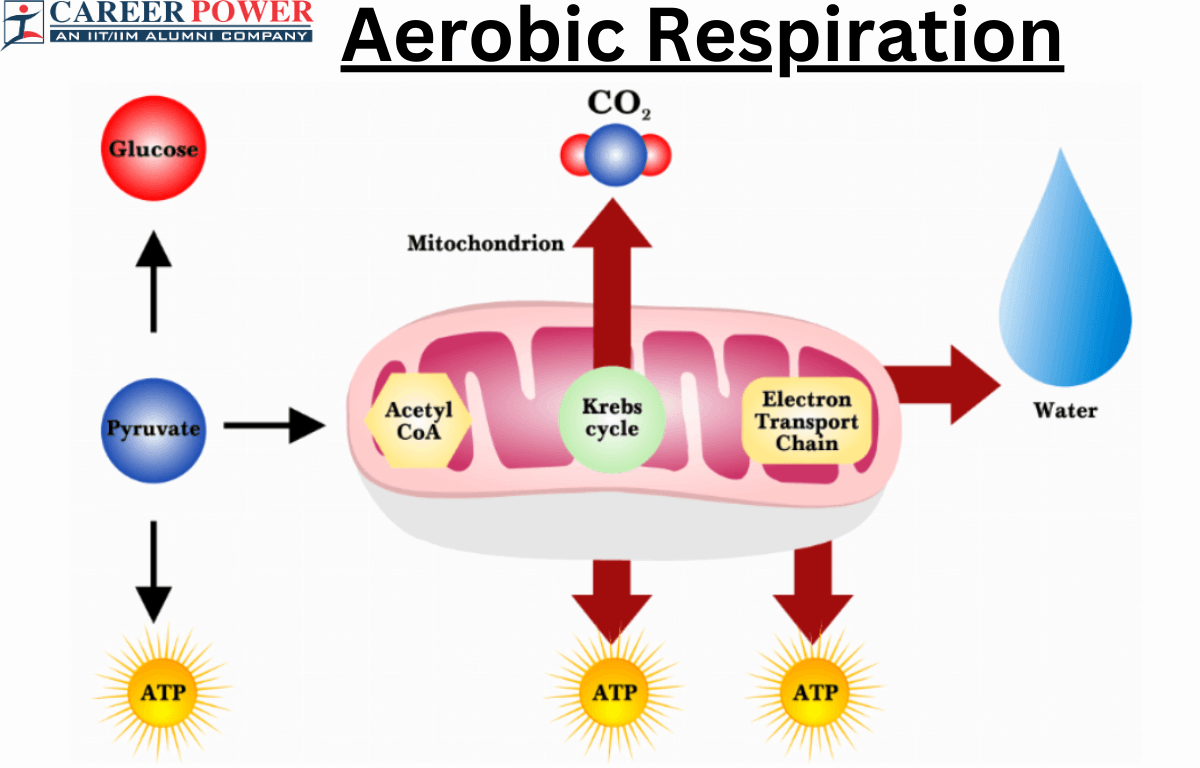Respiration is a very important process in biology by which organisms obtain energy from glucose and release carbon dioxide. There are two main types of respiration: Aerobic Respiration and Anaerobic Respiration. Aerobic respiration occurs in the presence of oxygen and is highly efficient, yielding more energy. Anaerobic respiration occurs without oxygen, yielding less energy and producing lactic acid or ethanol as byproducts. Different organisms utilize these types of Respiration based on their environmental conditions and metabolic needs. Here we have briefly discussed aerobic respiration.
What is Aerobic Respiration?
Aerobic respiration is a biological process that occurs in the presence of oxygen and is the most efficient way for cells to produce energy. During aerobic respiration, glucose, and oxygen are used to generate ATP (adenosine triphosphate), the cell’s primary energy currency, along with carbon dioxide and water as byproducts. This process takes place in the mitochondria of eukaryotic cells and involves several stages, including glycolysis, the citric acid cycle (Krebs Cycle), and the electron transport chain.

The process of aerobic respiration yields a much higher amount of ATP compared to anaerobic respiration, making it the preferred method for energy production. The process of Aerobic respiration takes place in humans, plants, animals, and other organisms.
Summary of Aerobic Respiration
In summary, aerobic respiration is a fundamental biological process that extracts energy from glucose and other organic molecules in the presence of oxygen, producing ATP as the primary energy currency while releasing carbon dioxide and water as waste products.
1. Oxygen Dependency: Aerobic respiration requires oxygen to function efficiently. It takes place in specialized organelles called mitochondria in eukaryotic cells.
2. Three Stages: It consists of three main stages namely Glycolysis, Kreb Cycle (Citric Acid Cycle), and Electron Transport Chain.
- Glycolysis: The initial breakdown of glucose into pyruvate, occurs in the cytoplasm.
- Kreb Cycle (Citric Acid Cycle): A series of chemical reactions that further breaks down pyruvate in the mitochondria, producing carbon dioxide and high-energy molecules like NADH and FADH2.
- Electron Transport Chain: The final step where electrons from NADH and FADH2 are transported across the inner mitochondrial membrane, leading to the production of ATP through mitochondria.
3. Carbon Dioxide and Water: Aerobic respiration produces carbon dioxide and water as byproducts.
4. High ATP Yield: compared to anaerobic respiration, aerobic respiration yields a significantly higher amount of ATP per glucose.
5. Primary Source of Energy: Aerobic respiration is the primary source of energy for various cellular activities.
6. Ubiquitous in Nature: This process is not exclusive to humans; it occurs in a wide range of organisms, including plants, animals, and various microorganisms.
Chemical Equation of Aerobic Respiration
The chemical equation for aerobic respiration can be written as:
C6H12O6 + 6O2 → 6CO2 + 6H2O + Energy (as ATP)
In words, this equation represents the process where glucose (C6H12O6) and oxygen (O2) are converted into carbon dioxide (CO2), water (H2O), and energy (in the form of ATP) through a series of metabolic reactions in cells. This process occurs in most living organisms to produce energy for cellular activities. This process of aerobic respiration is also essential for providing the energy needed for plant growth, development, and various metabolic activities.

Steps of Aerobic Respiration
Aerobic respiration is a complex process that occurs in cells to produce energy. Aerobic respiration produces a much larger amount of ATP compared to anaerobic processes, such as fermentation. This process is highly efficient and is the primary way that organisms, including humans, generate energy for cellular functions. Here are the basic steps involved in the process of aerobic respiration:
Step 1: Glycolysis
This is the first step that occurs in the cytoplasm of the cell. During glycolysis, one molecule of glucose is broken down into two molecules of pyruvate, producing a small amount of ATP and NADH in the process.
Step 2: Pyruvate Decarboxylation
The pyruvate molecules produced in glycolysis are transported into the mitochondria. In the mitochondria, each pyruvate molecule is converted into acetyl-CoA while releasing carbon dioxide.
Step 3: Citric Acid Cycle (Krebs Cycle)
Acetyl-CoA enters the citric acid cycle, a series of chemical reactions that occur in the mitochondria. This cycle generates ATP, NADH, and FADH2 as it breaks down acetyl-CoA.
Step 5: Electron Transport Chain (ETC)
NADH and FADH2 produced in earlier steps deliver high-energy electrons to the electron transport chain. Located in the inner mitochondrial membrane. As electrons move through the ETC, they generate a flow of protons (H+) across the membrane, creating an electrochemical gradient.
Step 6: ATP Synthesis
The electrochemical gradient created by the ETC drives protons back into the mitochondrial matrix through a protein complex called ATP synthase. This movement of protons powers the synthesis of ATP from adenosine diphosphate (ADP) and inorganic phosphate (Pi).
Step 7: Oxygen as the Final Electron Acceptor
Oxygen is the final electron acceptor in the electron transport chain. It combines with electrons and protons to form water (H2O), which prevents the buildup of excess electrons in the chain.
Examples of Aerobic Respiration
Aerobic Respiration is a metabolic process that occurs in the presence of oxygen, and it’s the primary way cells generate energy (in the form of ATP). Here we have mentioned some examples that will illustrate the wide range of organisms and situations in which aerobic respiration is crucial for energy production.
- Cellular Respiration: This is the most common example, occurring in the mitochondria of eukaryotic cells. It involves three main stages: Glycolysis, the Krebs Cycle (Citric acid cycle), and the electron transport chain.
- Human Muscle Activity: During activities like running, biking, or swimming, your muscles require a lot of energy. Aerobic respiration provides this energy by breaking down glucose and fatty acids with oxygen.
- Plant Respiration: Just like animals, plants also undergo aerobic respiration to produce energy for growth and other metabolic processes. Oxygen is taken in through tiny openings called stomata.
- Aerobic Bacteria: Many bacteria, such as those found in soil, water, and the human gut, perform aerobic respiration to obtain energy from organic compounds.
- Yeast Fermentation: Yeast can switch between aerobic respiration depending on anaerobic respiration depending on oxygen availability. In the presence of oxygen, they undergo aerobic respiration, producing carbon dioxide and water as byproducts.
- Brain Function: The brain primarily relies on aerobic respiration for energy. Even when you’re at rest, your brain consumes a significant amount of oxygen and glucose for its metabolic processes.
- Fetal Development: Developing fetuses in the womb rely on aerobic respiration to meet their energy demands until they are born and can breathe oxygen independently.



 50 Vegetables Name for Kids in English a...
50 Vegetables Name for Kids in English a...
 Food Chain: Definition, Types, Examples,...
Food Chain: Definition, Types, Examples,...
 Human Respiratory System: Definition, Di...
Human Respiratory System: Definition, Di...













